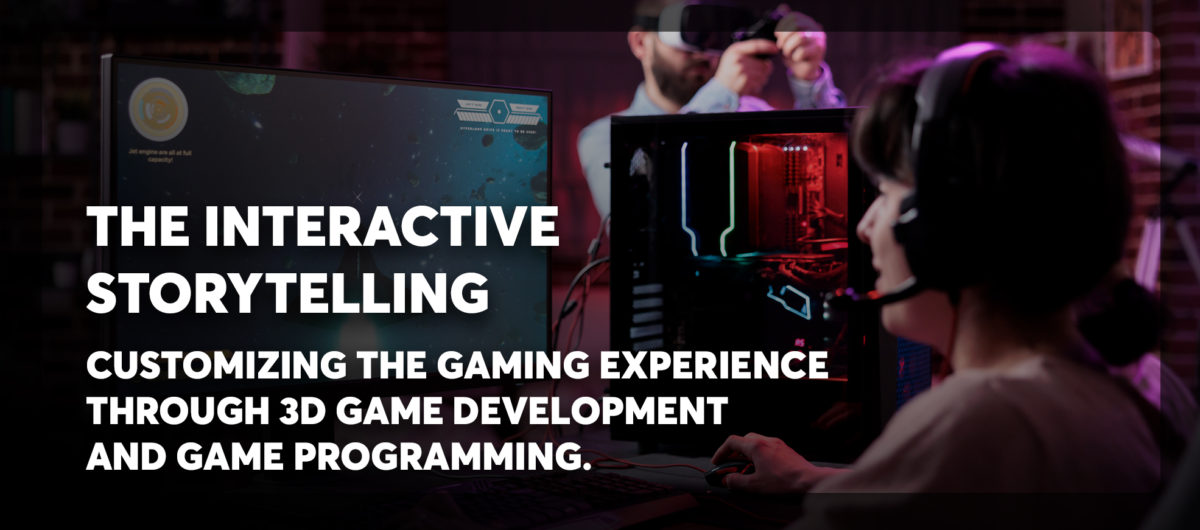The Interactive Storytelling: Customizing the Gaming Experience through 3D Game Development and Game Programming

The dynamic realm is where the intricacies of 3D game development and game programming converge, just like storytelling and technology—a chance to create synergies that make these elements essential in crafting interactive narratives within the gaming landscape. At the heart of this narrative-driven journey lies a commitment to storytelling. Whether it’s the evolution of game mechanics, the immersive experience of 3D environments, or the intricacies of programming, storytelling is the guiding force. Just as in the Mass Effect trilogy, where the developers experimented with game mechanics while unwaveringly prioritizing the narrative, we witness the narrative’s pivotal role in shaping the gaming experience.
Defining Interactive Storytelling:
At its core, interactive storytelling involves the real-time customization of a game’s form and content, tailoring the experience to maximize player enjoyment. The focus shifts from the technological attributes or characteristics of the medium to the different levels of interaction provided by computer games. The critical components include difficulty levels and gaming rewards and challenges.
Player-Centered Approach:
The first step involves player modeling or profiling, dynamically reconfiguring the virtual world to offer personalized gaming experiences. The second step in this approach goes beyond story plots to parameters such as the physical appearance of the virtual world, the traits of virtual characters, rewards, and difficulty levels.
Customization Levels for Optimum Gaming Experience:
Five customization levels are essential for optimizing the gaming experience: story structures, virtual world, virtual agents, rewards, and difficulty. Customizing the gaming experience requires constant monitoring of player actions within the virtual world, allowing for real-time modifications to enhance the overall gaming experience.
Understanding Player Psychology:
Understanding player psychology involves considering personal and situational factors influencing motivation to reach a gaming goal. There is a need to look at a motivational framework based on psychological needs to comprehend player preferences better, going beyond traditional play styles or player types.
Game Development: Crafting Digital Realms:
Game Development serves as the canvas upon which virtual worlds are painted. Delve into the intricacies of conceptualizing and designing games, recognizing that the story concept often serves as the inception of these projects. The narrative guides the development process and becomes integral to the player’s journey, offering unique entry points and immersive experiences.
The Dynamics of 3D Game Development:
Step into the third dimension, where the magic of 3D Game Development transforms pixels into palpable landscapes. Explore modeling, texturing, lighting, and animation principles that bring games to life. The narrative, woven into the fabric of these 3D worlds, becomes a driving force, influencing both the visual spectacle and the player’s interactive experience.
Game Programming: The Invisible Artistry:
Beyond the visuals, Game Programming emerges as the invisible architect shaping the interactive experience. Unravel the algorithms and data structures that breathe life into games. As the narrative unfolds, the code adapts, offering players a dynamic and responsive journey. Java Programming Games, in particular, stand out as a powerhouse, providing a versatile language for game development.
Gaming Courses: Bridging Passion and Profession:
Gaming courses bridge passion and profession, offering insights into game design principles, development methodologies, and Java programming games. The Asian Institute of Design has a 12-month diploma with a cutting-edge curriculum in Game Art, Development, and Game Programming. The diploma will enable you to get a job immediately in the AVGC industry; AID courses lay the foundation for a future generation of developers shaping the next era of interactive storytelling.
As we navigate the nexus of Game Development, 3D Game Development, Game Programming, Gaming Courses, and Java Programming Games, storytelling emerges as the common thread weaving through these diverse elements. The synergy of creativity, technology, and education propels us into a future where immersive narratives redefine the possibilities of interactive entertainment. As technology continues to evolve, the intersection of interactive storytelling and game programming promises to redefine the boundaries of player engagement and satisfaction. Whether it’s the evolution of game mechanics, the immersive experience of 3D environments, or the intricacies of programming, storytelling remains the guiding force. Like in the Mass Effect trilogy, where developers experimented with game mechanics while unwaveringly prioritizing the narrative, we witness the narrative’s pivotal role in shaping the gaming experience.
Similar Articles
-

Mastering 2D and 3D Animation 03-04-2025
The Ultimate Career Boost in Today’s Creative Industry The demand fo
-

How to Make a Graphic Design Portfolio? 02-27-2025
Imagine walking into a room full of potential clients or employers, bu
-

What are the 12 Principles of Animation? 02-27-2025
Animation is more than just moving images—it’s the art of brea
-

The Changing Face of the Animation Industry 02-27-2025
The animation industry has undergone a seismic transformation over the
